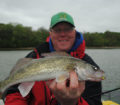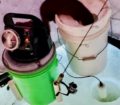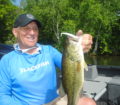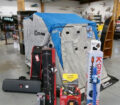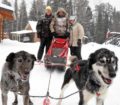By Steve Weisman
Outdoor Editor
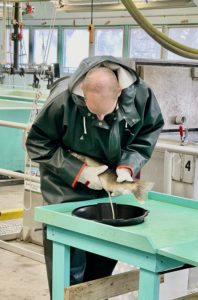
(photo by Steve Weisman)
Stripping the eggs from a ripe female walleye.
If I were to describe the DNR biologists and technicians at the Spirit Lake Hatchery as they went about their gill netting this past week, I would use two words: dedicated and resilient. Gill netting began on Monday night ((April 11), and it was a great night with excellent weather.
A total of 115 females were brought in from East Okoboji, along with 50 males. Big Spirit pumped out 104 females and 235 males. With this many males, only a few males were kept the subsequent nights.
Tuesday night (April 12), well you know what that night was like. Storms were all over northwest Iowa. Luckily, the stormy conditions stayed pretty much east of the Iowa Great Lakes. However, the wind was a different situation. According to Kim Hawkins, Spirit Lake Hatchery manager, the wind switched several times during Tuesday night’s netting, which made things even more crazy. With veteran gill netting crews, she pretty much left it up to the teams to decide where and when to net for the night. For the night, 60 females and 24 males were collected from East Okoboji, while 98 females and 361 males were collected on Big Spirit. One boat caught the majority of those males, capturing 349 to be exact. Since, they didn’t need any more males, all of the males were released.
Then came Wednesday night (April 13), and its high winds. One crew member’s job was simply to control the motor just to make sure that the boat was kept in position! A total of 45 females and 10 males were taken from East Okoboji, while 237 females and 10 males were collected from Big Spirit, a really good number considering the conditions.
Things have a way of working out
When the process began, the goal for the Spirit Lake Hatchery was to collect 100,000,000 million eggs with the end result achieving 75,300,000 walleye fry. To achieve this, the goal was to bring in 1,065 ripe females. That was going to be a challenge with the crazy weather, but yes, “things have a way of working out…”
Most years, the Rathbun Hatchery relies on getting excess eggs collected at Clear Lake and Storm Lake to fill its quota. However, the Rathbun Hatchery experienced a much better than normal walleye gill netting season, so it was able to meet its quota quickly. As a result, starting on Wednesday, the eggs collected at Clear Lake and Storm Lake were delivered to the Spirit Lake Hatchery. Pressure off, and yes, “things have a way of working out.”
For that reason, Thursday night (April 14) was the final night to collect the remaining few females that were needed to meet the quota. A total of 11 females and 9 males were brought in from East Okoboji, while 82 females and 29 males were brought in from Big Spirit. Job done!
And none too soon, with the cold weather dropping the surface water temperatures down and more wind was in the forecast!
The netting process ended up bringing in 752 females and 676 males for a total of 1,428 walleyes.
Northern pike and musky requests met
The 2022 request for northern pike was 1,700,000 eggs resulting in 750,000 fry. A total of 97 females and 98 males were collected from Big Spirit over five days.
The 2022 request for musky was 1,200,000 eggs resulting in 250,000 fry. A total of 35 females and 58 males were collected to meet that request.
Reminder: Hatchery open to public
It is so nice to be able to once again visit the Hatchery and see the efforts of the DNR biologists and technicians. It’s now open from 8 a.m. to 8 p.m. for the next several weeks. Walleye broodstock will be in the hatchery until April 20, while the big muskies will stay until the end of April.
Hawkins says, “It is great to see faces back in the hatchery this season! We have missed sharing our hatchery with the public. It’s always fun to see the excitement on kid (and adult!) faces when they see the big fish in the tanks and all the eggs in jars.”
Yes, you’ll also be surprised at the major renovation that took place beginning in the fall of 2021. After 60 years, it was definitely time.
For one thing, the incubation system has now been changed over to a recirculation system that no longer relies on lake water. The water is also climatically controlled and much easier to regulate. Plus, this will keep the egg incubation portion of production free of zebra mussels so that fish can be stocked from the facility without having to treat the truck water and fish to ensure they are zebra mussel free when they reach the stocking site. In addition, the new recirculation system will help fight bacterial problems and infections eggs saw in previous seasons due to the use of lake water.

